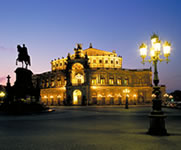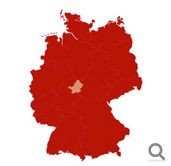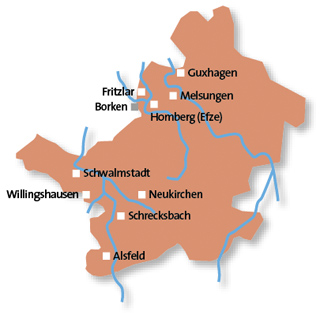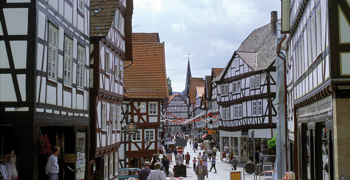
Historical Towns
- Historical towns in Brandenburg
- Cathedral Towns and Cities in Saxony-Anhalt
- The innovative Anhalt-Wittenberg Region
- Enchanting towns in the Harz
- The beautiful towns and cities in Saxony
- Towns and cities of culture in Thuringia
- Beautiful towns of Franconia
- East Bavarian traditional towns
- Alpine towns in the Allg�u
- The eastern Akpine Foothills and their towns
- Towns and villages in the western foothills of the Alps
- Mediterranean towns on Lake Constance
- Towns in the Swabian Alb
- Unspoilt towns in the Black Forest
- Towns for refined tastes in the Heilbronner Land
- Towns in the Odenwald
- Wine towns in Rheinhessen
- Saarland, a region of contrasts
- Romantic towns in the Hunsr�ck and Nahe Regions
- Idyllic towns and villages in the Moselle Region
- The Ahr Rhine Eifel holiday region
- Wine towns on the Romantic Rhine
- Modern towns and cities in the Bergisches Land Region
- The Lahn Valley and its fairytale towns
- Historical towns in Kurhessisches Bergland
- Sauerland's scenic towns
- Fairytale towns in the Weserbergland Hills
- Majestic towns in the M�nsterland Region
- The nine stars of Lower Saxony
- North and East Frisian Islands
- Vibrant Schleswig-Holstein
- Maritime towns along Mecklenburg's Baltic Coast
- Historical Hanseatic Towns
- Germany's Baltic Sea Islands
- The Mecklenburg Lakes
Contact and information
A journey back through time medieval architecture, idyllic landscapes and lakes

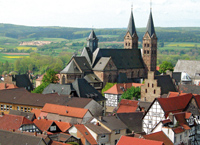
Imperial Fritzlar and its cathedral
Timber-framed houses from the 15th to the 20th century, walls and towers from medieval fortifications and the imposing presence of St. Peter's Cathedral form a harmonious ensemble in Fritzlar. A former centre of imperial power, the town derives its name from the Old German for `place of peace', marking the place where the spread of Christianity by St. Boniface began. With its uninterrupted half-timbered backdrop, the market square is considered one of the prettiest in Hessen. Attractions of historical importance include the House of the St. Michael's Brotherhood dating from 1480, the Wedding House and the Spitzenhäuschen from 1415, an ancient crooked residence covered in wooden shingles and the town's oldest timber-framed house. At 37 metres high, the Grey Tower is the tallest town watchtower still standing in Germany.Alsfeld
Take a journey into the past and discover Alsfeld's medieval town centre, a superb monument to medieval and Renaissance town architecture. Once surrounded by an oval town wall with four gates, the Alsfeld old town is one of the most eye-catching and enchanting in the Kurhessisches Bergland. The abundant half-timbered buildings, which provide a comprehensive overview of the history of wood-building from the late Middle Ages to the beginning of the 19th century, follow one after another to form a harmonious whole.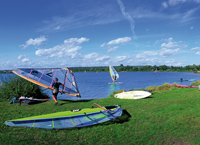
Borken (Hessen)
With its natural swimming lake, conservation area and many other smaller lakes, the Borken lakeland region is one of the most popular recreation areas in northern Hessen. Lake Singlis is ideal for holiday activities including an `aqua' driving range with targets on the water. It is also an insider's tip among windsurfers, with the favourable location and large surface area ensuring constant wind from spring to late autumn.Melsungen
The wealth of historical timber-framed houses in Melsungen points to its close relationship with the surrounding forest. In the Middle Ages, the townsfolk lived primarily from tree-felling. The woodsmen ventured into the forest over a mighty stone bridge, whetting their barten (axes) on the parapets. Notches from their tools are still visible today on the Bartenwetzerbrücke (axe whetter bridge). In a tradition that dates back to the 16th century, the symbolic figure of an axe whetter appears twice daily from the tower of Melsungen's threestorey, half-timbered town hall.Homberg (Efze)
Homberg on the Efze river derives its name from the von Hohenberg knights who turned the basalt peak around which the town is built into a hill fort. At Hohenberg Castle, you can see the illuminated, bricklined basalt well which is the deepest in Germany at 150 metres. The Homberg townscape is dominated by the widely visible towers of St. Mary's, one of Hessen's largest Gothic hall churches. In 1526 the Reformation movement spread from here throughout Hessen.Schwalmstadt
An abundance of lovingly restored medieval buildings has earned Schwalmstadt a place both on the German Half-Timbered Houses Route and the German Fairytale Route. At the heart of the medieval ensemble is the town hall with the Roland fountain. Remaining sections of the old town walls and the Hexenturm (witches' tower) on Untere Steingasse bear witness to Schwalmstadt's colourful history. The finest example of Schwalmstadt's half-timbered architecture is the bailiff's residence in Ziegenhain, a district of the town which began life as a moated fortress in the 16th century.Good food and good beer
In Kurhessisches Bergland people like their food hearty and flavoursome. The region has a long tradition of home-produced meat with a range of specialities on offer including liver sausage, blood sausage, stock and weckewerk, a sausage made of cooked brawn and minced meat. Another classic and a popular snack in the local taverns is the ahle worscht, a smoked and airdried pork and herb sausage with a natural skin and a long maturing period. Provided it has not been exposed to the air, the sausage keeps for up to a year. It is served with a wedge of rye bread and a draught beer produced by the Hessian Löwen brewery.Travel Planner
Select an option...
Romance and charm
Pay a visit to Garvensburg Castle and enjoy a leisurely stroll in the beautiful park. The estate has many wonderful details to discover and offers a romantic atmosphere for guests at the hotel, diners at the restaurant and day-trippers in the café.
Food and drink
Melsungen becomes the culinary capital of northern Hessen for one day during the Speciality Festival. The town's half-timbered houses provide the perfect backdrop for a mouthwatering exhibition of foods and dishes from small local producers.
History and tradition
The Salatkirmes fair has been celebrated in Schwalmstadt-Ziegenhain since 1728. It is now one of the largest festivals in northern Hessen and remembers the day on which Landgrave Karl invited local farmers to a feast of salad and potatoes in Ziegenhain.
Nature and scenery
Knüll wildlife park provides a home to 40 different species of animal in a natural enclosure covering around 50 hectares. Bears, wolves, badgers, wild horses, bison, lynx, eagle owls and wild cats are among those that roam here.
 Skip to content
Skip to navigation
Skip to subnavigation
Skip to search
Skip to content
Skip to navigation
Skip to subnavigation
Skip to search




